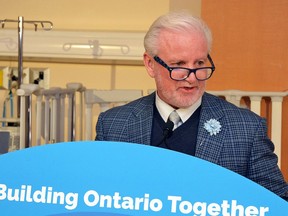Frustrated by his recent experiences, Roger Hathaway took to social media and asked a question on a local Facebook group.

Frustrated by his recent experiences, Roger Hathaway took to social media and asked a question on a local Facebook group.
Advertisement 2
Article content
“For those of us without a family doctor,” he wrote, “why is there no walk-in clinic in Stratford? Do I really want to drive to Kitchener?”
Article content
Fifty-one people responded, with some suggesting the city needs a clinic to handle a growing population and the influx of summer tourists, while others suggested different options — after-hours clinics, hospital emergency departments or making the trek to another city, like Listowel , Woodstock, Kitchener or London, that has a walk-in clinic.
“Stratford deserves and warrants a walk-in clinic,” Hathaway said. “I’m just surprised the nearest walk-in clinic is at least 30 minutes away.”
The 73-year-old hasn’t been able to find a family physician in Stratford since moving to the city in September 2013. He still has a part-time residence – and family doctor – in Toronto, but making the trip back for an year appointment is impractical. His daughter, now almost 40, has several health issues and spends weeks at a time with him in Stratford.
Advertisement 3
Article content
When she needs care, which was the case before Christmas, Hathaway takes her to Stratford General Hospital’s emergency department. They waited more than eight hours that last time, Hathaway said and while the care was great, he felt differently about the process.
“When you’re there, you look around and there are people who aren’t well, and they’re there because they don’t have a family doctor,” he said. “When people are waiting there, it defeats the purpose and contradicts the word emergency. People are there in non-emergency situations because they don’t have a doctor and don’t have a walk-in clinic.”
Andrew Williams said there hasn’t been a walk-in clinic locally in his 21 years as president and chief executive officer of the Huron Perth Healthcare Alliance, a group of hospitals in Clinton, St. Marys, Seaforth and Stratford.
Advertisement 4
Article content
“We need to figure out a local solution with our local providers that mitigates the need for walk-in clinics to be introduced,” he said.
Walk-in clinics are set up by private businesses when there is enough of a local demand to make them economically feasible. While they provide an alternative to emergency department visits and the care may be quicker, Williams said there is no continuity of care since most physicians staffing the clinics are from outside the region. Any followup, such as imaging, falls to existing, local providers.
There are other complications with walk-in clinics, he added, such as absorbing health-care professionals who could be working in the existing system and adding to access problems that already plague the province. Physicians are also financially penalized if a patient waits at a walk-in clinic.
Advertisement 5
Article content
It’s had a modest effect on area emergency departments, though average wait times at HPHA hospitals for low- and high-emergency patients not admitted were all below provincial targets, according to the latest data from November 2023. The average wait in Stratford for low- urgency patients, the kind most likely without access to primary care or feel access isn’t timely enough, was just short of three hours.
“Everybody is working hard and doing their best,” Williams said, “and I’m a firm believer that people who live in our community and pay taxes deserve care in some form.”
There are 6.5-million Canadians without access to primary care, and approximately 2.3 million of them live in Ontario. Local numbers were not immediately available from the Ministry of Health.
Advertisement 6
Article content
Williams called it the biggest shortcoming of Canada’s health-care system.
“It is a national embarrassment that has been enabled over the decades by all of us in and supporting the system,” he said. “Timely access to team-based primary care needs to be a top priority nationally and provincially, and policymakers must set a date for this to become a reality and then hold those who can make it happen accountable.”
Williams championed the need to advance innovative, local solutions through organizations like Ontario Health Teams. There are two family health teams in the HPHA umbrella, with 28 doctors at five sites in Stratford, Milverton and Tavistock that also offer after-hours clinics.
In the coming months, Williams said the HPHA will be more involved in Ontario Health Team discussions around building on the primary care that exists across its region and further advancing “timely, comprehensive, teams-based primary care for those living in Huron-Perth through active engagement with appropriate providers to advance a true system of integrated care.”
Advertisement 7
Article content
The Primary Health Care Nurse Practitioner Program is one agency that can bridge the gap for those without primary care, though there is a long wait list locally. Home care services, community agencies and mental health agencies require referrals.
Williams also suggested being creative with existing health-care partners, like pharmacies. Larger communities, such as London, can offer urgent care centers like the one at St. Joe’s, he said.
Longer term, Williams cited the need for a clear plan provincially and nationally that ensures graduating the right mix of health-care professionals necessary to support the needs of the population.
“This is a very complex issue,” he said. “There’s a lot of moving parts, a lot of players involved. We have a lot of commitment locally to provide best health care we can. We know there are gaps and there are alternatives to people, but we are very committed to strengthening access to teams-based primary care in the region, and I think we’ll see some positive moves in that direction in the coming years.”
Article content